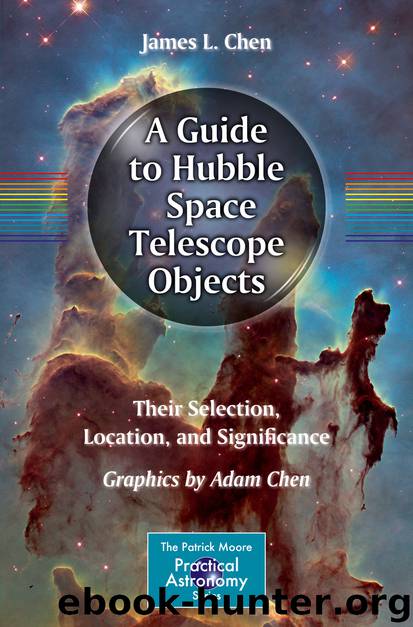A Guide to Hubble Space Telescope Objects by James L. Chen & Adam Chen

Author:James L. Chen & Adam Chen
Language: eng
Format: epub
Publisher: Springer International Publishing, Cham
M15 is perhaps the densest of all (globular) star clusters in our Milky Way galaxy. The Hubble Space Telescope has photographically resolved its superdense core, as seen in Fig. 5.1. M15’s core has undergone a process of contraction called “core collapse”, which is common in the dynamic evolution of Milky Way globular clusters. This central core is extremely small compared to the cluster, only about 0.14 arc minutes (8.4 arc seconds) in angular diameter, corresponding to a linear extent of roughly 1.4 light years. The half-mass radius is 1.06 arc minutes, or linearly about 10 light years—half the mass of this cluster is concentrated in the innermost sphere of that radius. It is still unclear if the central core of M15 is packed so dense simply because of the mutual gravitational interaction of the stars, or if the core is home to a black hole. M15 is among the nearest and better observable globulars to possess a collapsed core, since it is only little more remote than the Galactic Center and is not obscured by dense interstellar matter. Similar Messier globulars M30 and M70 also contain collapsed cores and are also being investigated in greater detail.
A total of 112 variables have been identified within M15, with one identified as a Cepheid Type II. Eight pulsars have been also identified within M15. M27 The Dumbbell Nebula
Alternative Nomenclature: NGC 6853, Apple Core Nebula
Download
This site does not store any files on its server. We only index and link to content provided by other sites. Please contact the content providers to delete copyright contents if any and email us, we'll remove relevant links or contents immediately.
Tools of Titans by Timothy Ferriss(7811)
Turbulence by E. J. Noyes(7700)
Astrophysics for People in a Hurry by Neil DeGrasse Tyson(5000)
Secrets of Antigravity Propulsion: Tesla, UFOs, and Classified Aerospace Technology by Ph.D. Paul A. Laviolette(4990)
Design of Trajectory Optimization Approach for Space Maneuver Vehicle Skip Entry Problems by Runqi Chai & Al Savvaris & Antonios Tsourdos & Senchun Chai(4839)
Room 212 by Kate Stewart(4733)
Pale Blue Dot by Carl Sagan(4613)
The David Icke Guide to the Global Conspiracy (and how to end it) by David Icke(4379)
A Journey Through Divination and Astronomy by Publishing Pottermore(4248)
Apollo 8 by Jeffrey Kluger(3512)
Goodbye Paradise(3444)
Losing the Nobel Prize by Brian Keating(3425)
COSMOS by Carl Sagan(3346)
The Five People You Meet in Heaven by Mitch Albom(3334)
How to Read Water: Clues and Patterns from Puddles to the Sea (Natural Navigation) by Tristan Gooley(3239)
Brief Answers to the Big Questions by Stephen Hawking(3239)
How to Read Nature by Tristan Gooley(3077)
The Order of Time by Carlo Rovelli(3073)
A Brief History of Time by Stephen Hawking(2819)
